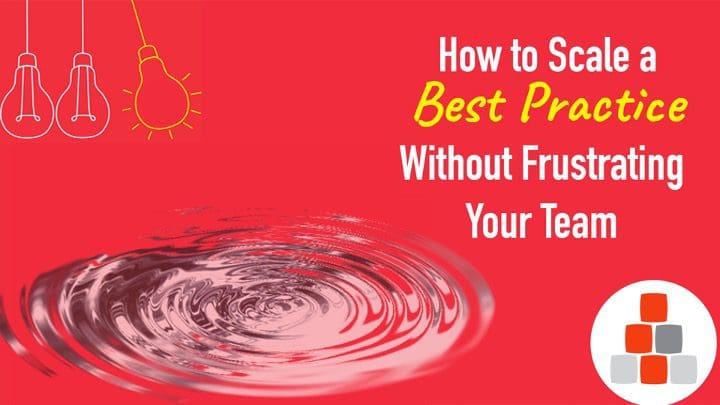To scale best practices, focus on how they work in different contexts.
Has this ever happened to you? Your top-performing team seems to have discovered the secret to transforming their productivity, customer relationships, or sales. And then you think, “It’s time to scale best practices –everyone needs this asap!”
We’ve worked with many executives who quickly rolled out the new best practice—only to be frustrated with spotty adoption and lackluster results. In the meantime, they’ve frustrated their team because that supposed best practice didn’t make any sense for the work they do, the way they do it, or the customers they serve.
The next time you find a best practice, we invite you to wait and dive a little deeper. When you get it right and everyone owns it, you’ll sustain your results and be ready for the next change.
Start Here to Scale Best Practices
Javier was a well-loved director and also an accomplished Italian chef. Every year he would conduct an operational excellence rally that he personally catered with spaghetti made from homemade noodles, handcrafted sausages from wild game he’d hunted, and a sauce he cooked himself with vegetables he’d grown in his garden. It was an annual labor of love for Javier. His team always left the annual rallies energized.
Another director in the same organization confided her doubts about her team ever performing like Javier’s: “I don’t boil water, much less cook like that. Our rallies are flat by comparison. I mean, I’d rather be with Javier’s team too.”
She’d fallen into a common trap that prevents many organizations from scaling best practices: she’d focused on applying the practice, not the principle.
A principle is a concept that works universally.
For instance, “Treat your customer with respect” is a principle of customer service. But the practice of respect can look very different from culture to culture, city to city, and between industries.
Cooking a homemade meal for your team is a practice. For most people, that practice isn’t transferrable. But the principle of personally investing and connecting to your team is transferrable—every trained leader can do that.
You don’t scale practices; you scale principles.
What to Do with a Winning Idea
Even if that new best practice looks good on paper, your leadership team is on board, and it worked well in the IT war room, the following steps will help you and your leaders to find the scalable principle and how to make it work in other contexts.
1. Ask Why It Works
Sometimes you’ll have to ask “why” several times before you get to the essence of what really happened or the fundamental reasons for success.
For example, you see John, a customer service rep, consistently getting high scores from his customers. When your manager explores, he discovers that John ignores the opening script your quality team prepared and connects with genuine empathy. The answer is not to rewrite the script to match what John says. Rather, tap into the concept of genuine connection and help all reps get there in their own way.
It takes courage to ask “why.” You might discover that your breakthrough was really a matter of luck and fortunate timing rather than a repeatable principle everyone can use. That’s okay.
Also, when you help your team members to think critically about their own ideas, they’re more likely to find meaningful solutions.
2. Test the Principle
Once you’ve found the principle in the best practice, test it, and see if it works the way you and your team think it does. Try it in different settings, with different people.
3. Listen Closely
As you test the principle and roll it out, really listen to what your people tell you. Check-in with stakeholders, partners, and customers. Respond to feedback with solutions, not selling. When you fix something, communicate the fix back to the team five times, five different ways.
4. Ask, How Can It Be Better?
As you continue to test and roll out the principle, ask questions that will help refine the principle:
- How can we address challenges and make the change serve its purpose?
- What’s working well and how do we leverage it?
- What enhancements do we need?
All these questions help refine the principle—and they also build morale by including employees in your change efforts.
Scale Best Practices by Localizing the Principle
Once you have a winning idea, one key to refining a best practice is to help your teams work out the principle in ways that make sense and get results in their specific circumstances.
Here’s an excellent example of how to localize a principle when you want to scale best practices: Three contact centers were asked to improve their customer experience by increasing the empathy in their representatives’ customer interactions. The principle was “more empathy,” but each center took a different approach.
Center 1
One center focused on prepaid-phone customers. These customers were often viewed poorly by the service reps. (Their view of who buys prepaid phones was biased based on a small percentage of bad experiences.) The lack of empathy translated to poor customer service. To address the issue, the manager gathered everyone together and showed them a picture of Betty, a kind-looking elderly woman.
He described Betty: “She is a retired nurse. She was a Girl Scout leader for forty years. She was married for fifty-one years to the love of her life—a veteran who died recently. Betty is a prepaid-phone customer. She’s also my grandmother. Next time you take a prepaid call, picture Betty on the other end of the line.”
“What about Betty?” became a best practice for the principle of empathy. Coaches and team leaders could say “What about Betty?” for an instant boost to customer empathy.
Center 2
The second contact center heard about the first center had done with their “What about Betty?” campaign. They loved the idea— only one problem: the manager didn’t have a grandmother named Betty.
Their leadership team took a look at the principle: a person-focused reminder of what empathy looks like and came up with their own campaign. Every day for a week, various baby shoes, bibs, bottles, and pacifiers were scattered around the center. Then signs started to appear, “What happened to baby Carl?” People were concerned and intrigued. “Who is baby Carl?” they asked. “And what happened to him?”
At the end of the week, the leadership team pulled everyone together and revealed the meaning behind the baby items. “We know from the conversations this week that you were very concerned about this baby. Well, Carl is an acronym. It stands for Care About Real Lives. When you’re struggling for empathy, think about baby CARL.”
Then they got an infant-sized baby doll and wrapped it in a blanket. At first, the doll was used to recognize great acts of customer empathy. Soon, however, agents who were tired or struggling with empathy asked to borrow the doll and place it on their desks as a reminder to care about real lives and summon their empathy. This localized approach worked in their center and had a significant impact on their empathy and quality scores.
Center 3
The third center went a different way entirely. To increase empathy, they focused on how their leaders would show up with encouragement and empathy. Their best practices included behaviors like all the supervisors lining up as team members arrived for their shifts, then applauding and cheering for them as they entered the center. Team leaders made a point of asking agents “How are you doing?” and listening to the answers, reflecting the emotions they heard—in other words, showing empathy.
All three centers achieved improvements in the customer experience by increasing empathy during calls. But each of them localized the principle in a way consistent with their culture and context.
Your Turn
Finding and localizing the principle in order to scale best practices is an incredibly powerful technique to create ownership, pride, and sticky customer (and employee) experiences.
It’s also difficult for your competitors to mimic because they can’t just copy the best practice–if they try, they’ll be the ones frustrating their team with ideas that don’t work the way they intended.
We’d love to hear from you: Where have you experienced a best practice that’s used in different ways in different places?
You can download a FREE chapter of our new book Courageous Cultures: How to Build Teams of Micro-Innovators, Problem Solvers, and Customer Advocates here.









What a great distinction between Practice and Principle. Shifts this scaling issue in a deft way!
Can even call it “How to scale best principles!”
Well said Ellen!